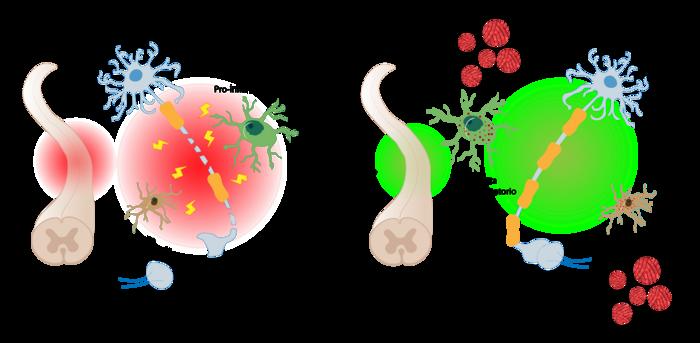Researchers Pietro Veglianese, Valeria Veneruso, and Emilia Petillo from Istituto di Ricerche Farmacologiche Mario Negri IRCCS, working with Filippo Rossi of the Politecnico di Milano, have shown in a study published in Advanced Materials that their novel nanovector, called nanogel, can deliver anti-inflammatory drugs to glial cells that are actively involved in the development of spinal cord injury, a condition that can result in paraplegia or quadriplegia.
 Nanogel - Scheme of selective drug treatment in the central nervous system. Image Credit: Politecnico di Milano - Istituto Mario Negri
Nanogel - Scheme of selective drug treatment in the central nervous system. Image Credit: Politecnico di Milano - Istituto Mario Negri
Current treatments for modulating the inflammatory response mediated by the component that controls the brain’s internal environment following acute spinal cord injury have shown little success. This is also due to the lack of a treatment method that specifically targets microglial and astrocytic cells.
The nanovectors produced by Politecnico di Milano, known as nanogels, are composed of polymers that can attach to particular target molecules. In this example, the nanogels were engineered to attach to glial cells, which play an important role in the inflammatory response after acute spinal cord damage.
The collaboration between Istituto di Ricerche Farmacologiche Mario Negri IRCCS and Politecnico di Milano demonstrated that nanogels loaded with an anti-inflammatory drug (rolipram) could convert glial cells from a damaging to a protective state, actively contributing to the recovery of injured tissue.
Nanogels demonstrated a selective action on glial cells, allowing the drugs to be released in a targeted manner, increasing their benefit while limiting potential adverse effects.
The key to the research was understanding the functional groups that can selectively target nanogels within specific cell populations. This makes it possible to optimize drug treatments by reducing unwanted effects.
Filippo Rossi, Professor, Department of Chemistry, Materials and Chemical Engineering ‘Giulio Natta,’ Politecnico di Milano
Pietro Veglianese, Head of the Acute Spinal Trauma and Regeneration Unit, Department of Neuroscience at Istituto Mario Negri, added, “The results of the study show that nanogels reduced inflammation and improved recovery capacity in animal models with spinal cord injury, partially restoring motor function. These results open the way to new therapeutic possibilities for myelolysis patients. Moreover, this approach may also be beneficial for treating neurodegenerative diseases such as Alzheimer’s, in which inflammation and glial cells play a significant role.”
Journal Reference:
Veneruso, V., et. al. (2023) Synergistic Pharmacological Therapy to Modulate Glial Cells in Spinal Cord Injury. Advanced Materials. doi:10.1002/adma.202307747.